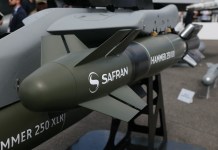The Ukrainian military is said to have destroyed Russia’s new Palantin electronic warfare (EW) system with precision artillery fire.
The newly adopted Palantin EW system was shown being destroyed in Ukrainian strikes in aerial footage made public by the Ukrainian armed forces. This is believed to be the first confirmed elimination of this system in Ukraine.
The video is released by the 128th Mountain Assault Brigade, also known as the 128th Separate Mountain Zakarpattia Brigade.
According to the defense blog, the unit said in a statement that “Russian newest EW complex “Palantin,” destroyed by high-precision artillery fire.”
But it is unclear exactly where Ukrainian forces destroyed the system. In June 2022, the defense ministry first revealed that it had deployed the Palantin EW system in Ukraine.
In September 2019, the Western Military District (WMD) press service reported that a Russian battalion tactical group used the Palantin electronic warfare (EW) equipment for the first time in training during an exercise near Voronezh.
The first confirmed destruction of recently adopted Russian Palantin electronic warfare (EW) system by Ukrainian artillery. pic.twitter.com/JNJYs6aJB4
— Clash Report (@clashreport) February 14, 2023
The technology can block hostile radio communication and electronic intelligence equipment over a 1,000-kilometer-wide area. The equipment’s capabilities allow for the short-wave and ultra-short-wave blinding of the adversary systems and the deprivation of cellular communications.
The system has several applications, including discrete radio frequency object targeting, bandwidth and frequency-specific jamming, and detecting rival EW.
Palantin can also build a system of systems by fusing different electronic warfare and reconnaissance networks into a single coordinated one to increase effectiveness.

Palantin, which translates into either “shoulder cloak” or “stole,” began to be used by the Western Military District in April 2019.
When Palantin is integrated with existing EW systems, it will reportedly be able to hinder the employment of precision-guided weapons by obstructing the precise position of possible targets and information transmission.
Russia’s Electronic Warfare In Ukraine
While recently adopted Russian Palantin EW equipment was destroyed by Ukraine, Russian electronic warfare has been successful there.
In terms of electronic warfare, Russia is seen to have already gained the dominant position over the conflict in Ukraine, taking out Kyiv’s drones.
According to a report released in November by the Royal United Services Institute (RUSI), Russian electronic warfare (EW) capabilities have destroyed most of Ukraine’s drones, reducing their lifespan to an average of three flights for small quadcopters and six for fixed-wing models.
The study added that 90% of the thousands of drones Ukraine was able to gather before Russia’s invasion in February were gunned down or wrecked by July, causing Ukraine to approach the United States and the North Atlantic Treaty Organization for new drones and fighter jets.
In a Forbes story published in May 2022, David Hambling highlighted that Ukrainian artillery operators were employing various drone models to deliver accurate artillery fire against Russian positions, attempting to make the most of their limited artillery ammunition supplies by striking important targets. During the early stages of the war, this edge might have saved Kyiv.

However, Ukraine’s drones are falling from the sky at an alarming rate. This makes it challenging to manage artillery fire, eliminates any precision advantage, increases Russian soldiers’ survival, and enables them to reassemble for additional offensive operations.
The implications of enhanced Russian EW capacity are also hurting the Ukrainian air force. The first to experience the effects of enhanced Russian EW, according to a December 2022 article by David Axe, was Ukraine’s fighter pilots.
He noted that the pilots regularly encountered that their radars had been disabled, their navigation equipment had been suppressed, and their air-to-air and air-to-ground communications had been jammed.
The EurAsian Times previously reported that the early success of Turkish TB-2 drones may not have resulted from the TB-2’s superior fighting abilities but rather the gaps in the Russian military.
Russian soldiers were reportedly exposed to TB-2 strikes because they deviated from the tactics, techniques, and procedures they were supposed to follow, which required them to operate under a strong air defense shield with EW capabilities.
Furthermore, during the early stages of the Ukraine war, Russian combat and EW units may not have coordinated well enough for the latter to use their capabilities to their fullest against the TB-2.
- Contact the author at ashishmichel(at)gmail.com
- Follow EurAsian Times on Google News




